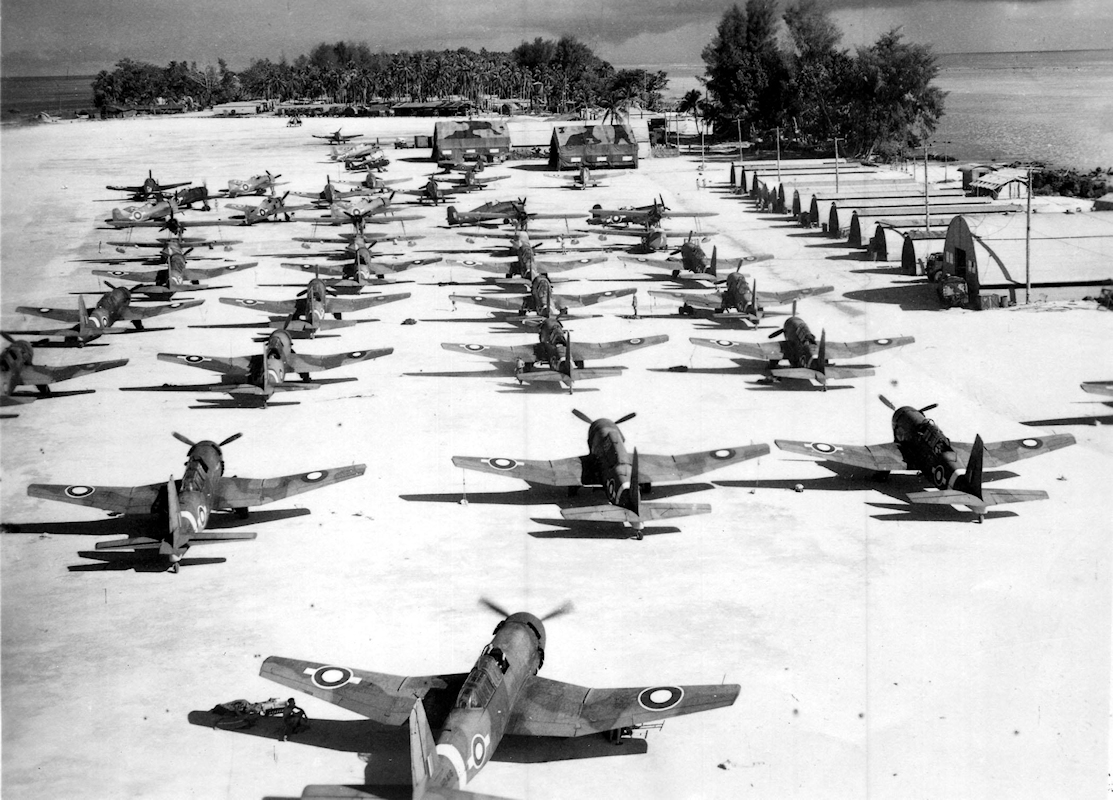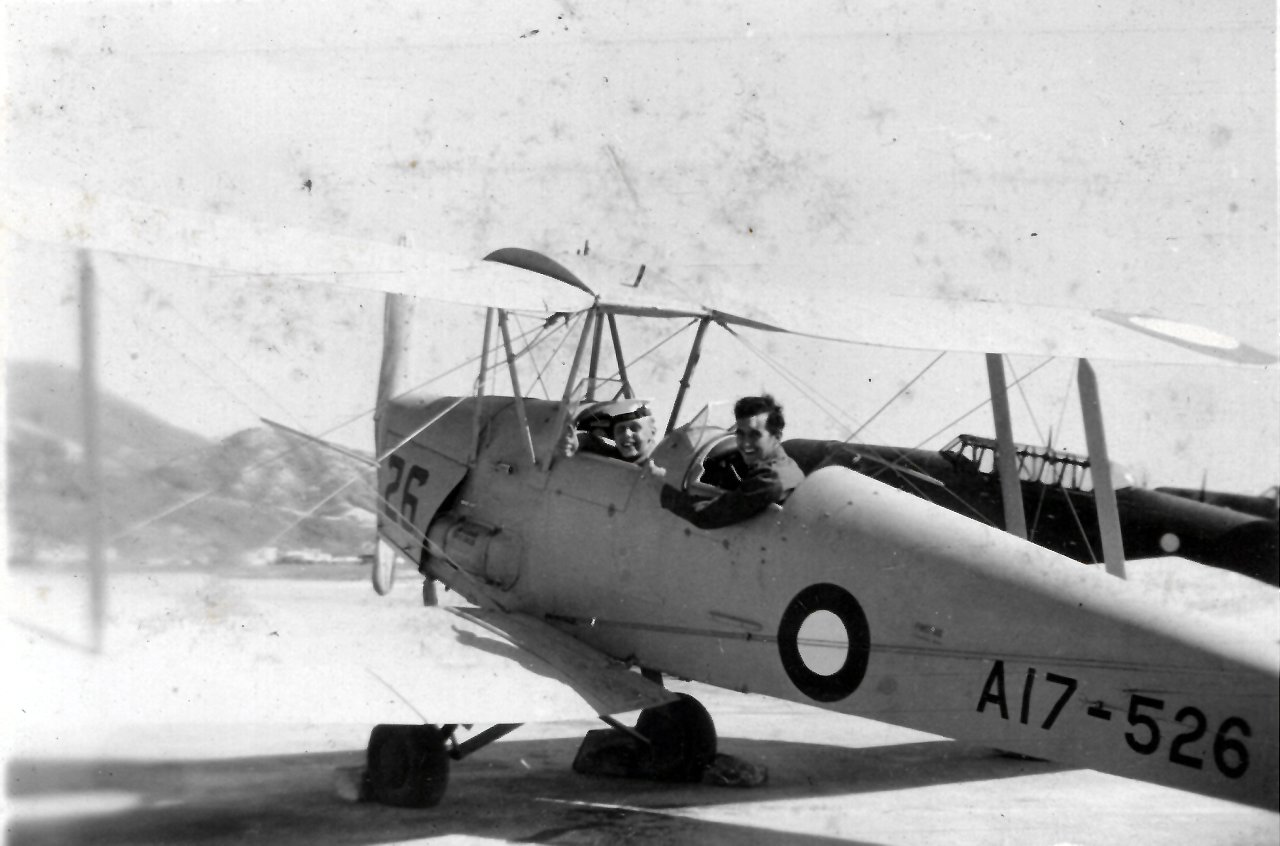



721 squadron assembled at RNAS Belfast on March 1st 1945, with 6 pilots and 6 Telegraphist Air Gunners , under the command of Lt.Cdr (A) F. A. Simpson, RNVR as a Fleet Requirements Unit for service in the Pacific. Initial equipment was 6 Vultee Vengeance TT.IV target tugs which were prepared for ferrying on the escort carrier HMS BEGUM; while at Belfast the aircrew trained on another 6 aircraft to familiarise them with the type.
The equipment, stores, aircraft, and personnel of 721 FRU and 1701 Air Sea Rescue squadron (6 Sea Otter) were embarked on April 17th; all aircraft were hoisted aboard. BEGUM sailed later the same day to join convoy KMF.43 which had sailed from the Clyde, on reaching Gibraltar BEGUM left the convoy and made independent passage to Port Said to transit the Suez Canal. On leaving the Suez Canal BEGUM continued on to Colombo where she took on fuel and stored ship before sailing for the Admiralty Islands, north of New Guinea in the south-western Pacific.
HMS BEGUM arrived off the Island of Ponam on May 27th and anchored overnight. The next day 721 FRU and 'B' Flight of 1701 ASR squadron were put ashore to RNAS Ponam, HMS NABARON. Ponam is small coral island lying close off the northern coast of Manus Island, the largest of in the Admiralty Islands group, situated two degrees south of the Equator, about two hundred miles north of the New Guinea coast and more than 2,000 miles from Sydney, Australia.

RNAS Ponam aircraft park and maintenance area; there are 17 Vengeance target tugs, identified by the single band painted on the rear fuselage, some belonging to 721 Sqn, 4 Sea Otters of 1701 Sqn & 14 reserve Hellcats are visible in the park. In the maintenance area next to the two Dorland hangars are 3 Reliant communications aircraft and 2 more Hellcats. A single Corsair is parked in the distance. The camp buildings can be seen in the tree line.
The island was only 1 mile long by ¼ mile wide. All aircraft had to be off loaded by lighter because of an encompassing coral reef which prevented the carriers from tying up to a jetty. The former American coral airstrip was on loan to the Admiralty and occupied by MONAB 4 (Mobile Naval Air Base 4) in support of the British Pacific Fleet in the forward operating area.
Flying operations began in June providing aircraft for radar calibration and gunnery exercises carried out by ships in the area; on the 12th a Vengeance (HB546) experienced control problems on its take-off run, it is believed that either the rudder or one of the ailerons locked causing the aircraft to swing to port. The aircraft crossed the airfield boundary and entered the lagoon. The aircraft turned over on impact with the water and quickly sank in 15 ft of water. Several Onlookers dove in to attempt a rescue and the pilot, Lt H Kirby RNVR was rescued. The following month the squadron had a second incident when HB374 flown by Sub-Lt. P. Builder RNVR, suffered a starboard oleo collapse when landing on July 28th. In August four Hellcat IIs were issued to the squadron, probably for radar calibration or fighter direction exercises.
After the end of hostiles in August 1945 the airfield at Ponam was being run down to closures and 721 FRU was embarked in the maintenance carrier HMS UNICORN on October 9th for passage to Australia. On arrival in Brisbane, Queensland on October 15th they were disembarked to RN Air Maintenance Yard Archerfield to regroup. While at Archerfield the squadron took leave before resuming training; a few additional aircraft were flown while in Australia, including Avenger I, Seafire III and a Mosquito, but these were left behind when they left for Hong Kong. There was one recorded incident during this period, Vengeance HB520 ground looped after landing on November 11th. With an increased inventory of 10 Vengeance TT.IVs. the squadron embarked in HMS SPEAKER for passage to Hong Kong, sailing on December 28th.
The squadron disembarked to RNAS Kai Tak, Hong Kong on January 11th 1946. The airfield at Kai Tak was a joint RN/RAF station, the RN (West) side of the station housed MONAB 8, HMS NABCATCHER . The former Japanese occupied airfield had been reopened by the RN and had accommodated several disembarked squadrons from the carriers that had liberated the colony and helped in the repatriation of detainees and POWs; at the time of 721 arriving there were only the 8 Sea Otters of 1701 ASR squadron on the station.
Part of 721 began operating with RN Mobile Malaria Hygiene Unit No. 1 when work began to eradicate the mosquito infestation from the colony; 3 of the Vengeance Target Tugs were specially modified aircraft transferred from the Royal Australian Air Force for DDT spraying, aircraft carried 320 gallons of DDT solution Spraying commenced on Friday, February 15th, 1946.
had an incident landing on, KD790 flown by Sub-Lt I. A. Hamilton, RNVR stalled and a wing dropped striking the runway.
Two of the specially modified Vengeance TT.IVs spraying DDT over Hong Kong in February 1946. Image © IWM (A 31060)
Tragically two squadron members were killed on march 1st when Vengeance HB363 went out of control in cloud and crashed into Junk Bay killing Sub-Lt A.M. Brodie RNVR and POAM E. J. Desborough. A new commanding officer, Lt (A) J. L. Moore RN, relieved Lt.Cdr Simpson on March 7th
In April Vengeance A27-545, flown by Sub-Lt N. C. Burrage, RNVR lost power on take-off on the 4th and had to abort, four days layer Vengeance HB305, flown by Sub-Lt I. Houghton RNVR crashed on landing when its undercarriage collapsed. There were two further incidents in May; on the 3rd Vengeance HB439, flown by Sub-Lt G. R. Harrison, RNVR suffered engine failure at 1,000ft over the airfield, it restarted at 300ft and a successful emergency landing was made. On the 23rd Vengeance FD303, flown by Sub-Lt J. Payne RNVR, swung off runway on take-off.
The squadron received an RAAF Tiger Moth (A17-526) in May, followed by several Corsair IVs which were issued from the reserve stock held on the station in June; this suggests an element of refresher flying training being added to the squadron’s duties. On August 27th the six Sea Otters and another RAAF Tiger Moth (A17-84) were received from the disbanding 1701 ASR squadron; these formed their own ASR flight. This was part of the reduction in British forces in the area, which also saw the RN presence at Kai Tak reduced in status to an R.N. air section, HMS NABCATCHER’s accounts mow being held in HMS TAMAR the local naval base.
Flying continued without incident into September when Vengeance A27-545, piloted by Sub-Lt G. R. Harrison, RNVR had a fire in the engine bay on the 24th (it unclear if this was on the ground or in flight). On October 10th one of the Corsairs had an incident landing on, KD790 flown by Sub-Lt I. A. Hamilton RNVR stalled and a wing dropped striking the runway.

Vultee Vengeance TT.IV 'F' over Hong Kong c.1946. The aircraft now wears its peacetime scheme of overall canary Yellow with black anti-glare on the upper engine cowling; the target drogue is streamed from the pod visible under the port wing.
On November 19th 1946 the squadron’s third commanding officer, Lt. R.,B. Head DSC took over from Lt. Moore. More new aircraft arrived at the beginning of November 1946, this time 2 of Seafire XVs. Both of these had flying accidents within weeks of their arrival; SW854 flown by Sub-Lt M. H. Simpson, RNVR made a heavy landing on November 11th and the undercarriage collapsed, on the 21st Sub-Lt N. G. B. Burrage, RNVR in SW801 had his prop strike the runway on take-off. Sub-Lt Simpson had another incident on the 29th, this time in Vengeance A27-619 which suffered engine failure and he made a forced landing.
By the end of 1946 the squadron operated two flights, ‘A’ flight operating Vengeance and Seafire XVs and ‘B’ flight operating Corsair IVs, with an ASR flight operating Sea Otters. In December 1946 ‘B’ flight embarked its Corsairs in
the Light Fleet Carrier GLORY, possibly for Deck Landing Training (DLT), there is a record of Lt.Cdr A. Haslam flying in Corsair KD749 for DLT, the aircraft bounced off the rounddown and ballooned into the carriers crash barrier on December 18th, another records the ditching of KD669 on January 9th 1947 after it suffered engine failure in the circuit and crashed into the sea, seriously injuring the pilot Lt. D. S. McKinnon, he died from his injuries on March 4th. On March 11th Sub-Lt J. S. Kennedy,
RNVR failed to return from q local exercise north-east of Hong Kong in Seafire SW854, it is believed he baled out when the aircraft ran out of fuel off China coast, but he was never found.

de Havilland DH.82A17-526 operated by 721 Sqn at RNAS Kai Tak. This was a Royal Australian Air Force aircraft transferred on loan to the RN and taken on charge at RNAS Bankstown on November 26th 1945. Picture C.1946.
On April 1st 1947 another administrative change
occurred –
HMS NABCATCHER was paid off and the Air Section re-commissioned the same day as HMS FLYCATCHER, the name formerly belonging to the MONAB formation station in the UK, accounts remained with
HMS TAMAR. The RN Air Section only handled one disembarked squadron in late October, early November 1947 and it was slated for closure. 721 squadron was disbanded on December 21st 1947, HMS FLYCATCHER paid off 10 days later on New Year’s Eve 1947.
Content revised: 23 October 2022
Additional sources:
Mobile Naval Air Base IV - History of H.M.S. Nabaron
Mobile Naval Air Base VIII - History of H.M.S. Nabcatcher

None
Vengeance TT.IV Mar 1945 - Dec 1947
Hellcat II Aug - Oct 1945
Corsair IV Jul 145 - Dec 1947
Seafire XV Nov 1946 - Nov 1947
Tiger Moth II May - Aug 1946
Sea Otter Aug 1946 - Nov 1947
Note: while at RNARY Archerfield also operated Avenger, Mosquito, & Defiant.
Lt. Cdr (A) F. A. Simpson RNVR 1 Mar 1945
Lt (A) J. L. Moore 07 Mar 1946
Lt (A) R. B. Head DSC* 19 Nov 1946
Squadron disbanded 21 Dec 1947
None
© 1999-2026 The Royal Navy Research Archive All Rights Reserved Powered by W3,CSS
Press F5 to refresh the page after posting your comment or to hide the form
Watch the gun camera footage from his course Click here
Close
Comments (0)